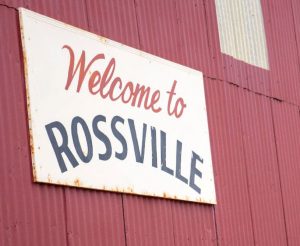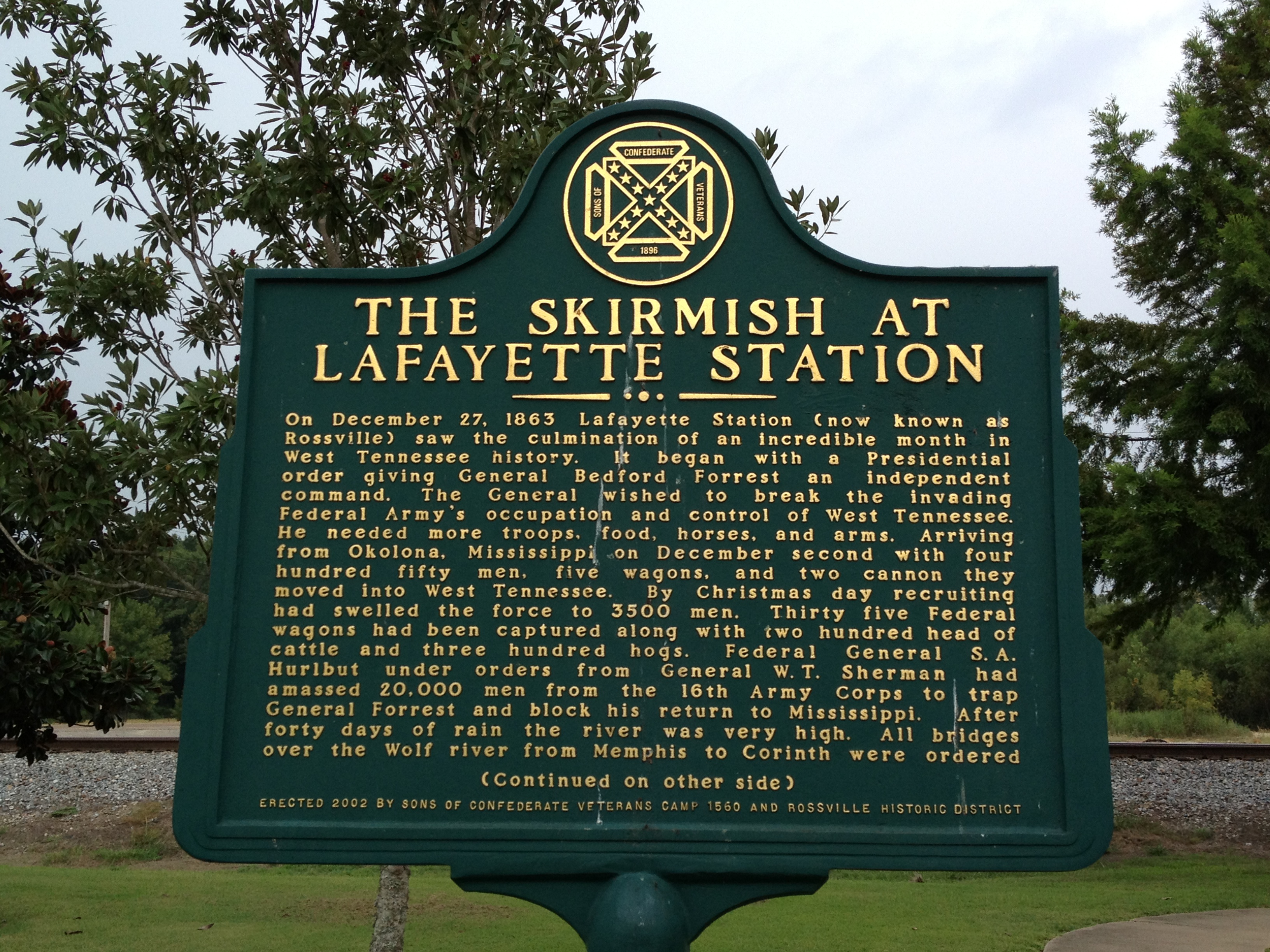
History
 The Town of Rossville is one of the old towns of Fayette County, Tennessee. It sprang from a village named La Fayette, which stood on Highway 57. The town received its name from General de Lafayette of France, who also gave La Grange its name from his hometown of La Grange, France.
The Town of Rossville is one of the old towns of Fayette County, Tennessee. It sprang from a village named La Fayette, which stood on Highway 57. The town received its name from General de Lafayette of France, who also gave La Grange its name from his hometown of La Grange, France.
Marie-Joseph Paul Yves Roch Gilbert du Motier, Marquis de Lafayette, (1757-1834) was a French general and statesman who, despite the opposition of his government, sailed for America in 1777 to join George Washington. In 1824-1825, he spent several months touring in the United States. Enthusiasm and admiration for him ran high among the pioneer settlers because of his active part in fighting during the American Revolution. Our county and town were named in his honor.
One of the early setters was Thomas M. Ross who gave the property of the present site to Rossville in 1859. Thus the town was renamed Rossville.
The first school, a one room building, was erected in 1866. The building was replaced in 1899 by two-story frame building, and many additions and improvements were made through the years. During the 1920s the older children rode the train to Somerville to attend school. For this daily trip back and forth to Somerville, the children rode “Old Mike.” Actually the engineer’s name was Mike Brady, but as the train took on a personality of its own, the train assumed the same name. Most of the Rossville students lived in the dormitories in Somerville. According to Mrs. Rosa Anderson, the train rides were the high-light of those years, and many a romance began on “Old Mike.”
In 1947 a new Rossville Elementary School was erected on Third Street. Miss Freddie Mae Thomas was among the staff of three, and she was responsible for the lower elementary. Some how Miss Freddie Mae was able to give a wonderful education to many of Rossville’s students. Often she had as many as 30 students in grades 1 through 6 in one room. One student fondly remembers how she separated the children in different areas of the room and went from group to group giving each child special attention.
The oldest home in Rossville is near the railroad tracks on Second Street and was built by Dr. A. V. Warr who came to Fayette County in 1855. The present owners have been engaged in extensive renovations and have restored its former beauty.
The first church in Rossville was built about 1870 by the Baptists. Both Baptists and Methodists used it until 1892 when the first Methodist church was built. Both denominations used the Methodist church building until 1920, when the Baptists built a church of their own on Second Street. When the Methodist church building was destroyed in a fire in 1922, the Methodists again used the Baptist church. On Easter Sunday in 1923, the first service was held in the new Methodist church, erected on land given by Mr. And Mrs. J. L. Crawford. The Methodists still worship in the historic church on Main Street. The Baptist congregation now has a new building on Highway 57.
Rossville was incorporated in 1903, and John B. Ballard was elected as the town’s first mayor. Many fine men have served as Mayor during Rossville’s Historic, and the town has maintained the friendly atmosphere that it had in the early settlement days when it had only a store, a grist mill, a blacksmith shop and three or four homes.
Rossville Has A Rich History Of Historic Homes

THE SKIRMISH AT LAFAYETTE STATION
The men of the “Critter Company” under the command of Brigadier-General Nathan Bedford Forrest enjoyed an unusual place of prominence in the army. The fact that they were Forrest’s boys gave them the respect that few others enjoyed. So when their commander received an order from General Bragg on September 28, 1863, transferring them to Major-General Wheeler’s command, there was great discontent. Forrest considered this the last straw and the final injustice. He wrote a scathing letter to Bragg and promised a face to face confrontation (Lytle 235). Several days later Dr. J. B. Cowan, Forrest’s chief surgeon, and Forrest rode up to Bragg’s headquarters at Missionary Ridge and strode into the tent without so much as a salute to the sentry on duty. Forrest immediately accused Bragg of “cowardly and contemptible persecution.” “I have stood your meanness as long as I intend to. You may as well not issue any more orders to me, for I will not obey them, and I will hold you personally responsible for any further indignities you endeavor to inflict upon me” (Wyeth 242-243). Forrest continued to list Bragg’s attempts to ruin him and his career by withholding arms and ammunition, by robbing him of his command in Kentucky to give to one of Bragg’s favorites, and by reporting lies (Wythe 238).
Forrest stated his grievance and his determination not to serve under Bragg to President Davis. Forrest expressed a desire for an independent command in Mississippi and west Tennessee (Wyeth 244-245).
This was the chain of events that set into motion the action in Tennessee which would conclude with the Skirmish at Lafayette Station. Forrest received his orders, and on the 16th of November he reached his new field of command. The nucleus of men that Forrest was allowed to take with him numbered only 279 (Lytle 243). He also expected to gain the manpower of Richardson’s brigade of two thousand West Tennesseans, but “only two hundred and forty were present for duty. The others had gone home, without leave, to see their kin and to get warmer clothes”(Lytle 245). How was Forrest to carry out his plan to occupy the western counties of Kentucky, all of the State of Tennessee between the Mississippi and the Tennessee Rivers, and North Mississippi with an army of five hundred and nineteen men who were poorly armed? Forrest would have to depend on volunteers and, as a last resort, conscription. Forrest’s agents began spreading through the country “like fire and water.” General Johnston reported that he already had about five thousand men. “I have never seen a more healthy spirit manifested anywhere than is shown by the people here. . . . The Federals are and have been conscripting in Southern Kentucky, and of one hundred and thirty conscripted at Columbus over one hundred have escaped and joined my command, They are coming in daily at the rate of fifty to one hundred per day, and as soon as it becomes known that my command is here, large numbers will leave the Federal lines to join us” (Lytle 247).
Forrest’s army began to swell, but he warned his superiors that his armies could not serve the Southern cause empty handed. He needed the promised arms and enough money to buy quartermaster supplies and wagons for transportation. His scouts informed him daily that the enemy combinations were forming to close upon him. The Federals had 750 troopers in Sommerville and “as many as 1000 more were in the vicinity of Bolivar and an equal force near Middlebury, on the Mississippi Central Railroad eastward of Moscow, with three large trains held at Lagrange full of infantry, ready to be dispatched withersoever needed to bar Forrest’s way back to the Confederate lines” (Jordan & Pryor 371). Union forces had headquarters in Memphis and some twenty thousand men were scattered in garrisons and in the field. There were 3,300 Union troops in La Grange (Lytle 245). Large detachments of troops were in Collierville and were kept day and night upon trains; the engines steamed and were ready at a moment’s notice to transport soldiers (Wyeth 263). The enemy planned to close on Forrest, and on the nineteenth of December,Union General Hurlbut wrote, “I think we shall cure Forrest of his ambition to command West Tennessee” (Lytle 250).
Forrest’s repeated requests for money and arms went unanswered. He had already spent twenty thousand dollars of his private funds, and he was sure that the enemy was preparing to move against him by the twenty-fifth or soon thereafter. Still no reply came and time grew precious so Forrest and his men began their march with a “force of raw, undrilled, and undisciplined troops” many of whom were unarmed (Lytle 249).
It had been raining for some forty days and the weather was intensely cold and the freezing mud and water was unbearable. The rivers were swollen, and Forrest would have to cross at a bridge to get his two hundred head of beef cattle, three hundred hogs and the recruits to safety. Forrest marched forward to Jackson, Sommerville, and bivouacked at Whiteville. If Forrest was going to make his escape, it would have to be done the next day, and he must decide that night where he would make his “break through.” By Union command, all the bridges between Memphis and LaGrange had been burned to prevent Forrest from crossing the Wolf River and making his escape into Confederate territory (Lytle 253).
In the meantime, Forrest’s scouts reported that Prince was at Somerville with force of seven hundred and fifty, at Bolivar there was a body one thousand strong, as many at Middleburg and other troops were troops massed in Memphis and Charleston east of Moscow. At LaGrange three trains were filled with infantry still steamed to move in either direction. General Hurlbut was secure near Corinth, where the streams were shallow, and he expected Forrest to cross (Lytle 253).
It appears that there was only one bridge remaining over the Wolf River between LaGrange and Memphis-that at LaFayette Station. Lieutenant John A. Williamson was sent with a small party to make a reconnaissance under cover of night. Williamson crept between the Federal pickets and the bridge and found that the flooring had been removed and was piled up on the southern bank. While concealed by the brush, he observed a body of Federal reinforcements who approached the guards stationed in the mud fort within 30 feet of the bridge. They struck a light, and relayed the boards allowing the troops to pass. The boards were again removed and neatly stacked (Jordan & Pryor 375).
At dawn on December 27, 1863, Forrest divided his force. Colonel Bell was ordered to advance to LaFayette Station with two hundred men to seize the bridge. Two hundred additional men were sent in the direction of Moscow to make the enemy believe that Forrest intended to cross between Moscow and LaGrange, and to cover his real line of march. Major Strange was sent directly to Memphis with seven hundred troops to cross over the Raleigh Ferry and make an attack on the town and sweep south as fast as they could go (Lytle 255).
At eleven o’clock in the morning, Bell approached the bridge at LaFayette Station under the cover of a dense wood on the north bank. Without hesitation, Bell’s men splendidly charged across the timbers of the bridge under a volley from the fort. Only a single volley was fired. The Federals observed the swarming numbers of yelping men who charged them at the outset, but they did not notice the unarmed condition of the main force. They quickly dashed for the road eastward toward Moscow leaving their strongly fortified position and four of their dead on the ground. Colonel John Newsom was sent in pursuit with fifty men to give the proper appearance. Within two miles, Newsom encountered a troop train, which he attacked with such vigor to cause the train to reverse the wheels, and he destroyed the track (Lytle 255)
By four P.M., the bridge had been relayed and Forrest had succeeded in crossing with his cattle, hogs, wagons and troops. Forrest left some of his older men in LaFayette to simulate farm people who would give false information about the main body of Forrest’s train to any Federal troops. The main body of unarmed men took the road to Holly Springs by way of Mt. Pleasant with orders to make a night march (Jordan & Pryor 376).
The crossing at LaFayette was entirely unexpected by General Hurlbut, who did not dream that Forrest would have the audacity to drive his “unarmed mob and his wagons and drove of cattle to the door of his headquarters and within sound of the large garrison at Memphis.” This was certainly a bold move by the General Forrest and “one of the cleverest pieces of strategy that Forrest practiced during the war” (Wyeth 264). A Federal writer sums up the results of Forrest’s operations on this occasion in these terms: “Forrest, with less than 4000 men, has moved right through the Sixteenth Army Corps, has passed within nine miles of Memphis, carried off over 100 wagons, 200 beef cattle, 3000 conscripts, and innumerable stores, torn up railroad track, cut telegraph wire, burned and sacked towns, run over pickets with a single Derringer pistol, . . .and all too in the face of 10,000 men.” (Correspondent Cincinnati Commercial, Memphis, January 12, 1864.) (Jordan & Pryor 379-380). “The Wizard of the Saddle had again done the unexpected and the impossible” (Lytle 257).
It has been the purpose of this paper to show the importance of the single bridge left at LaFayette Station as the only escape route for Forrest at this crucial point in the war. Many of the details of his one-hundred-and-forty-mile march with 3000 unarmed men, a large wagon train, cattle and 600 armed men has been omitted. During this march his troops fought successfully five combats losing only an estimated 30 killed, wounded or captured. The bravery and loyalty of the men under Forrest is praised in numerous accounts. “Forrest entered West-Tennessee at Saulsbury on the 4th of December with only some 500 men, two guns, and five ordnance wagons, and quit it at LaFayette Station on the 27th with 3500 men, well mounted, 40 wagons and teams loaded with subsistence, 200 head of beef cattle, 300 hogs, and his artillery intact” (Jordan & Pryor 379).
Rossville City Hall
360 Morrison Rd • Rossville, TN 38066
Phone: (901) 853-4681 • Monday – Friday, 8:00 am – 4:30 pm

